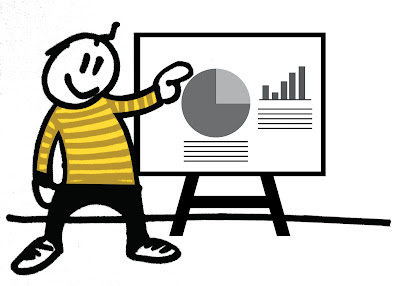
Ideas are great, and business models rule the world, but no matter how great an idea might be, a poor presenttation can ruin every chance of getting people to buy into it. The following tips can help you package a killer presentation that will not only wow your audience but will also get them to believe in you....
1. Decide what you want to achieve.
Firstly decide on what you want to achieve. For example, assuming this is in a business context, you might want to obtain new business enquiries. You need to ask for this during or at the end of your presentation. I recently made a presentation on branding and offered a one on one branding workshop to audience members – this had a good response and achieved my objective of making follow up meetings. You should ask the organizer for the audience's contact details and send them your presentation. Use your handout to encourage further dialogue and leave business cards.
2. THINK, TALK, ASK
You need to know your audience's expectation, venue, size of audience, time available and equipment etc
Audience profile
There is nothing as good as knowing who will be attending your presentation, their professional background, their personality, and if possible what they want to hear. This will go a long way in helping you decide how your want to get your message across to them
Venue and equipment
Ask questions as to what is available and where you will be presenting, a prior visit to the venue will be a big plus. Come with your own equipment since it will be a lot easier for you to set your own equipments up. This include your laptop, a projector (your own or rented). Going for presentations with your own equipment shows you are not a joke.
Timing
Find out When you are presenting and what time you have to make preparations?, How long it will take you to get to the venue, leave time out for traffic. If there are other presenters, what is the order, are you presenting first or last.
3. Content is king
A great visual style and enthusiasm is never a cover up for poor content – ensure you presentation delivers valuable information. However, while you are doing this, don’t be tempted to overload your audience with unnecessary information just to impress or hide the fact that you don’t really have a point to make. Prepare a presentation that will make your audience ask for copies of your slides when you are through.
4. Plan it out
Knowing the key points that you want your audience to take away, is a great place to start planning the structure of your presentation's content. Beginning with the key points of your message, determine what information or arguments will need to be made to deliver each of them effectively. Before you begin designing your slides and adding content, spend time at this planning stage to find the most effective order or sequence for your content to be presented in.
6. Keep it short and simple
Make your content as simple as possible, this surely is not an easy task but then, the shorter the better. Ask yourself “what is the essence of my message?” and “what three things do I want my audience to take away from my presentation?" You can shrink you content productively by using pictures, pictograms, illustrations to explain your content
7. What if your are the audience?
Imagine yourself as the audience, ask yourself what would I love to hear if I happen to be the audience and what will I dislike in a presentation. This will help you decide what your presentation style will be like. Above all, there is nothing as annoying as reading from the screen. It’s your presentation, so you should know better. The points and images on the slide are to create a picture for what you have to say, they are not the message.
8. Direct you message at someone
There is nothing as boring a presentation that doesn't contain words like YOU, WE, US. Using words like these helps connect the audience to you message. Ensure at some particular time in your presentation, make eye contact with people, (However, do not stare). Eye contacts help build confidence and also tells them you know what you are saying and you are not scared of saying it. Remember, you are talking to people and there is room for response. IT IS NOT NETWORK NEWS.
9. Tell a ( short interesting) story
The data and concepts in your presentation can often be effectively illustrated through real world examples or anecdotes. However the rules of clarity and brevity that apply to the rest of the presentation also apply here. In addition to this, while personal anecdotes can be more effective than a quoted source; beware of sounding boastful. Your lunches with the chief execs on their yacht are of no interest to your audience! No one is interested in the fact that you play golf with Aliko Dangote.
10. Build up your own confidence
A confident delivery is obviously more effective than being nervous and hesitant. If you are not a naturally confident person then being sure of your material and well rehearsed are your best allies. Try to rehearse your presentation in front of a test audience, your friends, colleagues. A mirror can help sometimes.
11. Design is KING
Well laid out slides will help create a picture for your message... ensure your presentations are well laid out, use relevant images and illustrations to nail your message, don't put an image to justify every point. Remember, less is more and white is beautiful. Use only relevant images, info graphics and messages on your slides.

